
This resource was created by the Washington Office of Superintendent of Public Instruction.
- Subject:
- Mathematics
- Material Type:
- Assessment
- Homework/Assignment
- Lesson
- Author:
- Hannah Hynes-Petty
- Date Added:
- 03/31/2020

This resource was created by the Washington Office of Superintendent of Public Instruction.

This resource was created by the Washington Office of Superintendent of Public Instruction.

This resource was created by the Washington Office of Superintendent of Public Instruction.
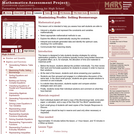
This lesson unit is intended to help teachers assess how well students are able to: interpret a situation and represent the constraints and variables mathematically; select appropriate mathematical methods to use; explore the effects of systematically varying the constraints; interpret and evaluate the data generated and identify the optimum case, checking it for confirmation; and communicate their reasoning clearly.
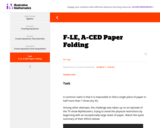
This is a very open-ended task designed for students to develop some of the basic ideas surrounding exponential growth. While implementations will vary (as discussed below), the core idea is that each fold of the piece of paper doubles the height of the stack. Combined with an estimate of the original thickness of the paper and the distance to the moon, this is enough information to deduce the minimum number of folds to get there. The solution uses the estimate of 0.1 mm for the thickness of paper and 385,000 km for the distance to the moon.

This simple conceptual task focuses on what it means for a number to be a solution to an equation, rather than on the process of solving equations.
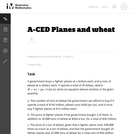
This is a simple exercise in creating equations from a situation with many variables. By giving three different scenarios, the problem requires students to keep going back to the definitions of the variables, thus emphasizing the importance of defining variables when you write an equation. In order to reinforce this aspect of the problem, the variables have not been given names that remind the student of what they stand for. The emphasis here is on setting up equations, not solving them.
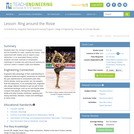
Students learn the concept of angular momentum and its correlation to mass, velocity and radius. They experiment with rotation and an object's mass distribution. In an associated literacy activity, students use basic methods of comparative mythology to consider why spinning and weaving are common motifs in creation myths and folktales.
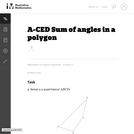
This problem provides students with an opportunity to discover algebraic structure in a geometric context. More specifically, the student will need to divide up the given polygons into triangles and then use the fact that the sum of the angles in each triangle is 180_.

Using a household fan, cardboard box and paper towels, student teams design and build their own evaporative cooler prototype devices. They learn about the process that cools water during the evaporation of water. They make calculations to determine a room's cooling load, and thus determine the swamp cooler size. This activity adds to students' understanding of the behind-the-scenes mechanical devices that condition and move air within homes and buildings for human health and comfort.
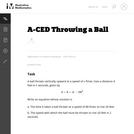
Although this task is quite straightforward, it has a couple of aspects designed to encourage students to attend to the structure of the equation and the meaning of the variables in it. It fosters flexibility in seeing the same equation in two different ways, and it requires students to attend to the meaning of the variables in the preamble and extract the values from the descriptions.

This resource is geared for teacher use. It is loosely linked to the Secondary Math II, Mathematics Vision Project curriculum.